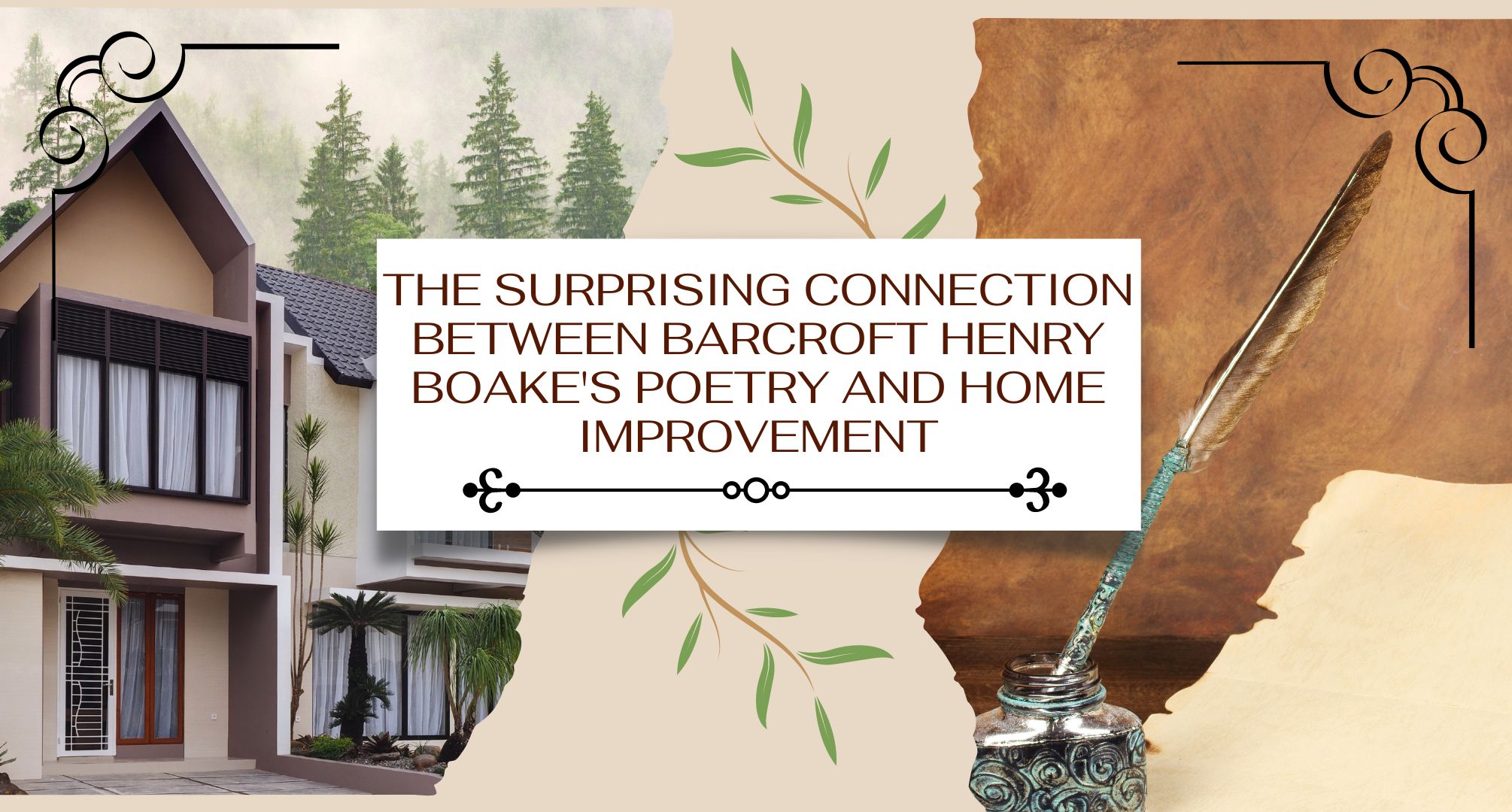WHO IS BARCROFT HENRY BOAKE ?
"Under the wattle tree, Oh, there no grief can be, A gladder heart than mine You could not wish to see." Where the Dead Men Lie
Barcroft Henry Boake, who resided in Australia in the 19th century, was a poet. Boake, who was born in New South Wales in 1866, was greatly influenced by the writings of Lord Byron and Percy Bysshe Shelley at an early age. In his early twenties, he started a career as a poet, which brought him immediate success. Boake is best known for his descriptive language of the Australian bush, but he also wrote extensively about nature, adventure, and the Australian environment. Boake was a poet who, despite early success, battled mental illness and ultimately ended his own life when he was only 26. Boake's distinctive voice and contribution to Australian literature ensure that he will be remembered long after his brief career came to an end.
Celebrating the Life and Poetry of Barcroft Henry Boake
KNOW MORE...
"Beyond the city's iron heart The rolling downs of my desire The riverine scrub and the scattered trees And the hills that hid my childhood's home."
The Short but Brilliant Career of Barcroft Henry Boake
Barcroft Henry Boake, who resided in Australia in the 19th century, was a poet. While his career was cut tragically short, Boake left an indelible mark on Australian writing with his singular perspective and arresting imagery.
Boake, who was born in New South Wales in 1866, spent his childhood in the state’s rural areas, where he came to have a profound respect and love for the natural world. He started writing poetry in his early twenties after being influenced by the writings of Lord Byron and Percy Bysshe Shelley. The Romantic poets had a significant impact on the young Boake, whose early works frequently dealt with subjects of nature, adventure, and the Australian bush.

Boake’s talent was soon recognized, and his poetry was featured in several leading Australian publications, such as The Bulletin and The Sydney Mail. His works received high praise for their accurate depictions of the Australian landscape and their ability to convey the adventurous and liberated spirit that was central to Australia’s sense of self at the time.
Where the Dead Men Lie, a poem written by Boake, first appeared in The Bulletin in 1891 and became one of his most well-known writings. The poem paints a vivid picture of life in the Australian bush and hints at the way the inhabitants of that country have a soft spot in their hearts for its harsh terrain. The poetry has gained widespread acclaim and is now regularly taught in Australian educational institutions.
Boake’s early success belied a lifelong battle with his own issues. He was depressed and alcoholic and was generally considered a restless, miserable person. Many of his poems deal with feelings of alienation, loneliness, and hopelessness, reflecting this interior turmoil.
Boake committed suicide at the young age of 26 in 1892, effectively ending his promising career. No one knows for sure what led to his demise, but it’s thought that he was under stress from money woes and the demands of his rising literary stardom. Boake had a relatively short career, but his legacy lives on thanks to his extensive collection of work.

Boake’s writing is particularly effective because it manages to convey the distinct character of Australia’s natural environment. His depictions of the Australian outback are evocative and full of life, and he has a surprising knack for capturing the spirit of exploration and independence that was central to Australia’s sense of self at the time.
In “Where the Dead Men Lie,” for example, Boake writes:
“Oh, the road to Gundagai is rough–
The cars and coaches jolt and sway,
With never a place where a man might stand,
For the wheels are hurrying all the day.
And the night comes down, and the stars are out,
The blankets round him are wrapt and bound,
And the winds of the winter’s night are chill,
And the wanderer sleeps on the ground.”
The wild beauty of Australia’s bush is captured in these lines, as is the feeling of freedom and adventure that comes with venturing into the wilderness. They also reflect the harrowing truth of living in the bush, where getting around is a pain and the climate can be unforgiving.
Boake’s poetry also reflects his own inner struggles and turmoil. In “The Song of the Broken-Hearted,” for example, he writes:
“Oh, the hopes of youth how fair they seem,
How fleeting too, as the dawn’s first beam
That sheds a glow o’er the sleeping stream–
The stream that is flowing to the sea.
The Many Facets of Barcroft Henry Boake: Poet, Adventurer, and Home Improvement Guru
I. Barcroft Henry Boake and his multifaceted life
Barcroft Henry Boake excelled at many various things in life.
He has accomplished a lot in his life, but here are just a few highlights:
1. Poet: Boake’s work stands out for its originality and evocative images. Both of his poetry collections, “Where the Dead Men Lie and Other Poems” (1897) and “The Golden Quest and Other Poems” (1898), were well accepted by the literary community.
2. Boake was a daredevil who worked as a drover and stockman across the entirety of Australia. He also served as a government cartographer in New Guinea. Boake’s poetry and other artistic endeavors were influenced by his time spent in the Australian outback and other isolated areas.
3. Boake was also passionate about fixing up and remodeling houses. He was well-respected in his field as a woodworker as well as carpenter, and his custom-made furniture and other domestic items were frequently praised. Boake’s adventurous spirit and appreciation for nature led him to advocate for the use of local resources and supplies in his house improvement endeavors.
II. Barcroft Henry Boake, the Poet
Barcroft Henry Boake’s schooling and family history both influenced his growth as a poet. In 1866, Boake was born in Sydney, Australia to parents who valued education and the arts. William Henry Boake Sr. was a well-known poet in his own right and an integral part of the intellectual community known as the Sydney Bohemians.
At Sydney Grammar School, where Boake studied as a young man, the English and Latin curriculum particularly suited Boake’s talents. His love of poetry and literature extended to the point where he would pen his own works in his free time. After finishing his formal education, Boake worked as a clerk for a while before striking out on a life of adventure and exploration in the Australian bush.
Despite leading a rather unconventional existence, Boake never stopped writing poetry. His poetry often reflected his appreciation for nature, sympathy for the underprivileged, and profound feeling of isolation and loneliness, all of which he derived inspiration from the beautiful nature and harsh life he faced in the outback.
Boake’s schooling and family history in the literary arts provided him with a deep well of knowledge from which to draw in his lifelong pursuit of poetry and literature. His early involvement with the Sydney Bohemian literary scene, coupled with his innate ability and devotion, led to the development of a distinctive poetic style that was at once expansive in scope and firmly rooted in the Australian bush.

III. Barcroft Henry Boake, the Adventurer
Boake’s poetry and other creative endeavors were greatly influenced by his vast travels and adventurous lifestyle.
Boake was an adventurer and drover in the Australian outback, where he was exposed to a broad variety of experiences and emotions that eventually found their way into his writing.
His travels impacted his writing in many ways, including but not limited to:
1. The poet Boake found a wealth of poetic inspiration in his journeys. In his poetry, he relied on the stunning scenery of Australia, the hardships of outback life, and the plight of the poor to create powerful and moving imagery. Meeting new people and learning about new countries during his travels fueled his imagination and improved the quality of his work.
2. Boake’s trips served as inspiration for many of the poems he wrote. His time spent in the outback inspired him to write about being alone and having to fight to stay alive in a hostile setting. In addition to exploring the horrors of colonialism and the lives of Australia’s aboriginal people, his writings often focus on nature’s grandeur and beauty.
3. The language and manner of Boake’s poetry owe a debt to his travels. Since he spent much of his time traveling among the working class, his writing frequently featured vernacular English and colloquial expressions. The author also played around with different poetic structures, using both conventional and experimental approaches to develop his own voice.
Over all, Boake’s trips were instrumental in shaping his work. His time spent in the bush and other isolated areas of Australia shaped his outlook on the world and the plight of the poor, which he later used to great effect in his writing.
IV. Barcroft Henry Boake, the Home Improvement Guru
Boake’s artistic and exploratory nature shone through in the unconventional ways he improved his house.
He was also an accomplished builder and woodworker, and he brought the same inventiveness and originality to his DIY house repairs that he did to his writing.
A few examples of how his artistic and risk-taking nature permeated even his house improvement efforts are as follows:
1. Boake was well-known for his inventiveness in the realm of home improvement, as he would frequently use available resources to construct one-of-a-kind furniture and useful household items. He used contemporary design principles in conjunction with time-honored methods to create functional and visually pleasing objects.
2. Boake’s approach to house improvement was distinguished by a keen eye for the tiniest of details. He spent hours perfecting his designs and ensuring that each item was expertly crafted, and he was meticulous in his selection of materials for each undertaking.
3. Boake’s adventurous spirit was clearly on display in his DIY house renovations. He loved to explore and innovate, and this showed in the fact that he was not afraid to try new things or tackle challenging tasks.
4. Boake’s approach to house improvement was heavily influenced by his appreciation of the outdoors. Throughout his travels, he made use of the local timber, stone, and clay whenever possible, showing his respect for the distinctive characteristics of each place he went.
Boake’s readiness to try new things and take calculated risks in pursuit of his interests was mirrored in the inventive way he went about fixing up his house.

V. The Many Facets of Barcroft Henry Boake: Bringing It All Together
Boake’s many passions and endeavors were deeply intertwined with one another.
He was a poet, an explorer, and a fanatic about house improvement; his body of work is a reflection of this diversity.
The following are just a few examples of the ways in which his various hobbies and interests informed and informed one another:
1. Boake’s experiences as an explorer and a DIY enthusiast informed many of the subjects that appear in his poetry and other works of art. The subjects of his affection for the outdoors, respect for native materials, and sympathy for the plight of the poor recurred throughout his poetry and construction efforts.
2. Boake’s poetry is inspired by his experiences as an explorer and a DIY enthusiast, both of which shape his use of language. As a result of his interactions with common folk during his journeys, he frequently employed slang and vernacular expressions in his writing. Like the meticulousness and originality of his home improvements, the poetry he wrote mirrored this same level of care and attention to detail.
3. Boake’s inventiveness in house improvement can be seen in his poetry. To develop his own voice, he toyed with different poetic styles and frameworks, using both established and experimental methods.
The same can be said for his house improvement projects, which frequently fused old-school methods with cutting-edge layouts.
Boake’s creative nature and openness to trying new things in pursuit of his passions were reflected in the intricate webs of connections that he wove between his many interests and endeavors.
VI. Conclusion
Both the artistic value of Boake’s life and work and the historical and cultural insights they provide make them pertinent even today.
A few of the methods in which his legacy lives on are as follows:
1. To that end, Boake’s poetry and other creative works shed light on the Australian identity and experience, especially as it pertains to outback life and the plight of the poor.
Scholars and general readers with an interest in Australian literature and society continue to find much to admire in his works.
2. Boake’s connection to the natural world is reflected in his respect for indigenous materials and his advocacy for ecological practices, both of which are still topical today. His method of house improvement, which prioritized using native materials and time-tested methods, can inspire modern initiatives to conserve energy and materials.
3. Because of the continued emphasis on invention and exploration in all facets of modern life, Boake’s pioneering and inventive spirit is still applicable today. His willingness to try new things and take chances is an inspiration to look outside the box and take risks in order to achieve one’s goals.
In general, Boake’s life and work are still pertinent today, serving as both a window into Australian culture and history and a wellspring for modern artistic endeavors. His life and work demonstrate how art and exploration can change our perspective on the world forever.
The Intersection of Creativity and Functionality: How Poetry and Garage Door Repair Meet
Garage door maintenance and poetry may seem like an odd couple, but they actually share a common ground in the intersection of artistic expression and practical application. Both call for an in-depth understanding of their respective fields’ specifics and an innovative mindset for approaching problems. This piece will examine the ways in which these apparently unrelated disciplines can share insights and build bridges.
Poetics, or the Craft of Verse
The literary art of poetry dates back many millennia. It’s a linguistic means of conveying mental and emotional states. Poets use devices like rhyme, meter, and allegory to give readers a one-of-a-kind and unforgettable experience.
Poets must first discover their subject, then select their words carefully, and then craft their expression into something meaningful. An in-depth knowledge of language and a desire to try new approaches are necessary.
Poetry has a way of unlocking latent imagination and ingenuity. It inspires authors to take a novel tack in their writing. Using only words, poets can elicit beautiful and powerful images and feelings in their readers.
The Value of Garage Door Maintenance

Repairing broken garage doors is an essential service for keeping buildings secure. Damage to property or physical injury are just two of the potential outcomes of a malfunctioning garage door.
It’s important to have a lot of technological knowledge when repairing garage doors. Garage door repair specialists should be well-versed in the many varieties of garage doors and the mechanisms that power them. They need to be outfitted with everything they need to make adjustments in a secure and timely manner.
When fixing a garage door, functionality must always come first. In order to solve problems, technicians must first correctly diagnose them. Aside from fixing the entrance, they have to make sure it works properly and securely.
Both poetry and garage door repair are creative and useful in their own ways, despite their obvious differences. Both disciplines call for technical know-how and expertise in addition to an imaginative approach to solving problems.
Techs who fix garage doors, for instance, might face unusual problems that call for original approaches to fixing. When a door is damaged beyond repair, a replacement must be manufactured to order, or when the motor stops working, a workaround must be devised.
The practical parts of garage doors can serve as muse for writers in a similar way. Well-maintained garage doors can provide a sense of calm and safety just by opening and closing them. The repetitive motion of a garage door opening and shutting can be interpreted as a symbol for the constant change that characterizes human existence.
The Value of Merging Artistic Expression and Practical Application
Both garage door repair technicians and poets can profit from fusing artistic expression with practical application.
For starters, it can help you become a better issue solver. Garage door repair technicians can find novel solutions to old issues by taking a fresh look at them. Poets have the ability, through the use of their imagination, to discover novel forms of expression that allow them to make a more personal and meaningful connection with their viewers.
Second, it can improve your interactions with clients and consumers. Customers are more likely to trust garage door repair services after speaking with an expert who can clarify any issues in plain English. Poets who can express nuanced feelings clearly and concisely give their readers a greater sense of connection to the poems they write.
Finally, technicians and poets equally can benefit from a combination of creativity and practicality in the workplace. Technicians take pride in their job and experience a sense of fulfillment when they are able to problem solve in novel ways. Poets find happiness and contentment in their work when they are able to convey themselves in ways that no one else has.
Conclusion

The worlds of poetry and garage door maintenance may seem worlds apart, but they actually intersect expressions of originality and practicality. Both call for in-depth understanding of complex systems and innovative approaches to fixing problems. Poets and garage door repairmen can benefit from each other’s expertise and perspectives by gaining insight and developing new ideas through discussion and collaboration.
To sum up, the connection between poetry and garage door maintenance may seem out of place, but it is actually quite potent because both require imaginative thought and practical application. Both fields call for an in-depth grasp of technical information and a can-do attitude toward problem solving. The combination of these two components allows us to create works that are both aesthetically pleasing and practical, serving to uplift and safeguard us.
The Surprising Connection between Barcroft Henry Boake’s Poetry and Home Improvement
Barcroft Most people are not familiar with Henry Boake, although his poetry contains insightful ideas that can be used in home maintenance and repair. Australian poet Boake, who existed during the late 19th century, penned poetry that were influenced by his appreciation of the natural world, his thoughts on solitude, and his perception of death. These topics, which are sometimes viewed as depressing and gloomy, can seem like an unexpected source of ideas for home repair tasks, yet they can be highly useful.

The Poetry of Boake’s Themes
The vivid natural descriptions, the reflective reflections on loneliness, and the contemplation of mortality that define Boake’s poetry. He typically employs nature as a metaphor for both life and death. His poetry frequently focus on the wonder and beauty of the natural world. These topics might at first glance appear unconnected to house repair, yet they can provide insightful information that motivates homeowners to start improvement tasks.
Home Improvement And The Environment
The vivid natural descriptions in Boake’s poetry are among its most striking elements. Few poets have been able to capture the essence of the natural world like he does. His poetry can encourage home owners to include natural elements to their interior design, whether it is by using organic building materials like wood and stone or by providing in plants and flowers.

For instance, “The Swagman’s Rest” by Boake, a wanderer who carries his things in a “swag” or bundle, describes a tranquil area where the swagman finds solace. Homeowners may be motivated to design a cozy outdoor area where they may unwind by the images of a “lone campfire” and “the stars that shone so bright” in the poem. This can entail creating a fire pit, setting up outdoor lighting, and growing shady and private plants and trees.
Separation and House Repairs
Boake’s poetry also touches on the subject of solitude. He talks on the benefits of solitude and how it can bring to contentment and tranquility. Home repairs, which can frequently be a solitary occupation, fit this topic.
Homeowners who can carry out repairs on their own may feel a sense of success and satisfaction. They can be pleased with themselves for being able to do a repair without a specialist’s assistance. This feeling of independence and self-sufficiency can be motivating and uplifting.
The poem “Where the Dead Men Lie” by Boake addresses the subject of solitude. In the poem, a bleak landscape is described, where “the air is black with the mourning of the dead.” Despite the melancholy appearance of this imagery, it can encourage homeowners to embrace solitude as a means of accomplishing home renovations. Homeowners might feel peaceful and accomplished by concentrating on the task at hand and working alone.
Improved Homes and Death
Finally, the subject of death is also a topic in Boake’s poetry. He discusses the transience of life and the certainty of death in his writings. Despite the gloomy appearance, this motif can serve as motivation for homeowners considering home remodeling tasks.
Homeowners who can embrace change and recognize that life is temporary may be more willing to start remodeling projects. Making their home “perfect” may not be as important to them as making it a comfortable and useful area that serves their needs.
This topic is effectively expressed in the poem “Shearers” by Boake, which describes a shearing shed as “weather-beaten and old.” The shed may not be ideal, but it serves its job and gives the shearers who work there a sense of security and familiarity.
Residents can apply this similar idea to their own residences by realizing that a home does not need to be flawless in order to be pleasant and useful and that flaws are a normal part of life.
Additionally, as a way to pay tribute to loved ones who have passed away, homeowners could be inspired to take on home repair tasks. Boake frequently addresses death and the notion of leaving a legacy in his poems. Homeowners can create a room that represents their individual taste and will be cherished long after they are gone by finishing home improvement projects.
Finally, Barcroft Henry Boake’s poetry makes an unexpected connection between home maintenance and repair. His observations of the natural world, thoughts on isolation, and comprehension of mortality can motivate home owners to embark on meaningful and practical remodeling projects. Homeowners can design a place that reflects their unique sense of style and will be cherished for years to come by incorporating natural elements into their spaces, embracing isolation as a means of finishing repairs, and recognizing the transience of life.
Don’t let a noisy garage door disrupt your inner poet: Get repairs now
You understand the value of solitude when it comes to writing poetry. Your writing flow may be disrupted by the sound of a loud garage door. It’s time to repair the garage door if the noise is keeping you from focusing.
In addition to being an irritation, a noisy garage door may indicate a more serious issue. If you choose to ignore the commotion, your garage door may end up broken. This can be inconvenient, expensive, and even dangerous.
Luckily, there are garage door repair experts who can help you fix the problem and get the quiet you need to write.
These are some arguments in favor of getting repairs immediately rather than letting a squeaky garage door ruin your poetic spirit.

Prevent Further Harm
A noisy garage door may indicate a number of problems, including old parts, misaligned tracks, or loose fasteners.
These problems, if ignored, might cause more harm to your garage door and even other areas of your house.
For instance, a misaligned garage door might cause expensive repairs or replacements to the door panels and tracks. An improperly balanced garage door might put unnecessary strain on the opener and lead to an early failure.
These problems can be inconvenient and result in extra costs which might have been prevented with prompt repairs.
The safety of you and your family may be jeopardized by a garage door that produces strange noises. For instance, a loud banging sound may mean that the garage door opener is having trouble lifting the door, which could lead to a sudden and dangerous collapse. Uneven or erratic operation of a garage door can also be risky.
If there are any problems with the safety features of your garage door, the experts in garage door repair will be able to find them and fix them. This will help you to relax and concentrate on your writing without worrying about the possibility of harm to yourself or others.
Take Use of the Silence
If you’re a poet, you know how important silence is to the process. A loud garage door can cause you to lose your train of thought, disturb your focus, and throw off your writing rhythm. It can be annoying and stressful, making it hard to unwind and get creative.
The silence you need to compose will return with a garage door repair. You may concentrate on your writing and unleash your inner poet by having a garage door that operates quietly.

Long-Term Financial Savings
In the short term, ignoring a noisy garage door may seem like a cost-cutting solution, but in the long run, it could end up costing you much more. A garage door that isn’t working properly might cause damage to other components of your home, such the walls and ceiling, which can be expensive to repair.
A malfunctioning garage door can also reduce energy efficiency, which can increase monthly power costs. In the long term, the garage door repair experts may be able to save you money on your energy bills by identifying and fixing any problems that are reducing the efficiency of your garage door.
Conclusion
As a poet, you are aware that ideas can strike at any time and that one must be in the correct frame of mind to let them to flow. Keep your poetic inspiration unaffected by a squeaky garage door. Have repairs done right away to prevent future damage, ensure your safety, restore tranquility, and maybe reduce costs.
Get in touch with a garage door repair service near you right away to set up an appointment. You may focus on your writing and unleash your inner poet after your garage door is repaired.
Regular maintenance can maintain your garage door in peak condition in addition to the advantages of repairing a noisy garage door. You can save money and ensure that your garage door runs properly for years by doing routine maintenance.
A qualified garage door technician, for instance, can look for damage like frayed cables, worn rollers, and a corroded track in your garage door. They can also fix loose hardware, lubricate moving parts, and fine-tune the tension on the springs. These minor adjustments and repairs can stop worse problems from happening, extend the life of your garage door, and save you money in the long term.
Also, routine maintenance can increase the energy efficiency of your garage door, resulting in lower monthly energy costs. By ensuring that the door is correctly insulated and closing any gaps or cracks, a skilled technician can assist regulate the temperature of your garage, which can have a considerable impact on the temperature of the rest of your home.
In conclusion, replacing a noisy garage door is crucial for the security, convenience, and sanity of any homeowner, but it’s especially crucial for poets and other artists who need quiet to create. You may receive the peace and quiet you need to write, prevent expensive repairs and safety issues, and maybe even save money on your energy bills by having your garage door serviced and maintained on a regular basis. Get in touch with a garage door repair service in your area right away to set up an appointment and ensure that your garage door continues to work properly for years to come.
Verse by Verse, Room by Room: Poets Reimagine Home Upgrades with a Literary Twist
It may come as a surprise that poets, those masters of metaphor and weavers of words, have a unique viewpoint to bring to the art of improving living spaces in a world when home renovation shows and blogs seem to go on forever. But when you give it some thought, you realize that poetry is closely related to the desire to infuse one’s surroundings with beauty, harmony, and meaning. Infusing their living environments with the same imagination that drives their writing, poets are blending their literary sensibilities into house improvements, according to this article.
Poetry Kitchen
The kitchen, where meals are made and memories are created, is the center of any house. Poets, who are renowned for their acute observation of life’s small pleasures, have a talent for reinventing this crucial area in ways that are both practical and artistically beautiful. Because they are aware of the expressive power of language, poets frequently select color schemes that evoke mouthwatering foods, such as the rich, comforting tones of dark chocolate or the warm, golden hues of honey.
Many poets choose open shelves to exhibit their cookbook collection because they love words. The cookbooks may be arranged by topics, colors, or even the rhythm of the authors’ names. Additionally, poets enjoy the tactile aspect of cooking and frequently use elements like reclaimed wood, natural stone, or hand-painted tiles in their culinary havens to add a sense of depth and history.
Library in the Living Room

The living room is frequently converted by poets into a haven for the written word. The walls are lined with floor-to-ceiling bookcases that hold their enormous and varied collections of literature in place of generic artwork or decorative items. In order to promote reading, writing, and reflection, the furniture was also carefully chosen. Cozy seats and sofas were placed to make pleasant nooks and crannies ideal for cuddling up with a good book.
Poets frequently experiment with unusual combinations of textures, patterns, and colors in their living room libraries in the spirit of creative license. For instance, a modern, sculptural coffee table or an old Persian rug might be matched with a strong wallpaper with a design based on a sonnet’s lines. The end product is a comfortable, visually appealing space that encourages original thought.
The bedroom as a haven
Poets frequently treat the bedroom, a place for rest and renewal, with veneration. They are aware of the significance of establishing a setting that promotes calm and permits daydreaming. In order to do this, poets frequently choose relaxing color schemes that are influenced by the natural world and its serene beauty, such as peaceful blues, soft greens, or mild pastels.
Poets frequently include beloved quotations, passages from their own writing, or even complete poems into the layout of their bedrooms, reflecting their love of language. These could be framed and hung on the walls, embroidered on pillows, or even stenciled on the bed’s headboard. In order to ensure that inspiration is never far away, poets are also known to designate modest, specific writing spaces within their bedrooms, replete with a comfy chair, an inspiring view, and a selection of their preferred writing instruments.
Garden as an Addition to the House
Many poets view the garden as an extension of their living environment because they find the beauty of the natural world to be a constant source of inspiration. Poets frequently decide to designate outdoor spaces as peaceful getaways for reading, writing, and meditation. A small pond or other water feature that serves as a calming backdrop for peaceful thought, seating places surrounded by fragrant flowers, or even a secret garden studio where people may write without being disturbed are some examples of these areas.
Poets frequently utilize plants in their gardens to convey their love of literature. They might decide to grow plants with symbolic value, like lavender for devotion or rosemary for remembering, or they might select flowers and foliage that have been described in their favorite poetry. The walkways in the gardens might also have been planned with poetic sensibilities in mind, with meandering curves and unexpected turns leading to secluded nooks and secret locations ideal for solitary introspection or unplanned bursts of creativity.
Using the bathroom as a refuge
When it comes to house improvements, the bathroom is frequently forgotten, but for poets, this room may be a welcome haven of isolation and shelter for both body and mind. Poets are notorious for transforming their bathrooms into serene retreats by adding opulent materials like marble or granite as well as fixtures that are both aesthetically pleasing and useful. They appreciate the importance of the little things and may choose for a deep soaking tub or a rainfall showerhead that promotes rest and renewal.
The poet’s bathroom decor is heavily influenced by words and language, just like the rest of their house. They might select poetry-themed pattern tiles or even hire a hand-painted mural that narrates a favorite tale or features a cherished literary figure. The poet’s bathroom is finished with soft lighting, scented candles, and a carefully chosen collection of poetry books, creating a setting that is both functional and poetic.

Poets redesign living environments with literary flair, making them not only aesthetically pleasing but also profoundly meaningful and inspiring. The poet’s home is a special combination of form, beauty, and creative expression because of the poet’s meticulous attention to detail, love of language, and keen observation of life’s basic joys.
Every room of their house exhibits the poet’s influence, whether it is the kitchen, the living room library, the bedroom sanctuary, the garden retreat, or the lavish bathroom. Poets show that the art of home improvement is not just about aesthetics but also about telling a narrative and making a statement by infusing their living spaces with the same creativity and passion that fuels their writing. By doing this, they demonstrate that the strength and beauty of the written word are the best possible inspirations for home improvements.
